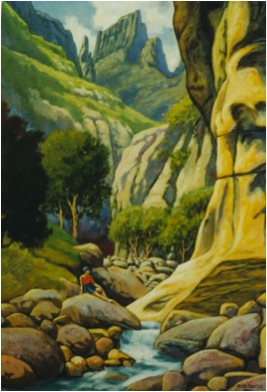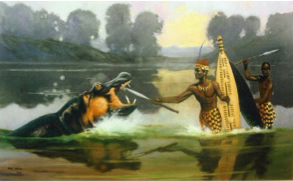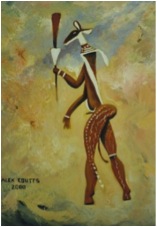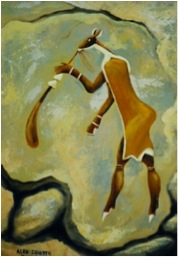ALEX
ART
|
|
Amazon Books and fine art; check for new gifts.
______________________________________________________________________________________________________________________________
|
ALEX-ART The wildlife subjects tend to be painted in a photo-realist mode, and are closely and accurately integrated with their habitat and wider environment. The landscape paintings are drawn from Southern Africa, and tend to be powerfully structural in composition, making a statement about the beauty, comparative permanence and complexity of major living and non-living natural forms. The figural and conceptual art incorporates figures from the historical and current realities of Africa. They sometimes use figural realities to illustrate and highlight one or other concept, but sometimes simply portray a scene worth recording, in empathy with the daily lives of a wide range of cultural communities. _________________________________________________________________________________________________________ Paintings are listed alphabetically _________________________________________________________________________________________________________
Abstract 1 _________________________________________________________________________________________________________ The work below, After the Storm,
depicts a Natal midlands farm scene after a
thunderstorm. Speckled Red, an old Nguni bull, is
accustomed to grazing on the farmhouse lawn where he
spent much time as a pet calf. His reflection in the
puddle has caught his eye, but he must be coaxed back to
the herd by the herdsman still in full rain gear. After the Storm _________________________________________________________________________________________________________ The following incident, Asking nicely, happened on the main beach at the coastal resort of Umhlanga Rocks north of Durban, during a children’s game. The big boy on the left is daring the younger child to retrieve the ball. The youngster sank down and then dived forward in an attempt to do so. It all ended with shrieks of laughter as others joined into the melee. Bright colours and an accentuated, brooding yet colourful sky helped to give a bit of life to the picture. With the tension between the boys as a focal point, the sea and surrounds were painted as impressions without much detail because they might otherwise prove a distraction. Asking Nicely _________________________________________________________________________________________________________ Autumn _________________________________________________________________________________________________________ The beachfront at Umhlanga Rocks is used daily by the fitness fraternity who run on the paved walkway or beach sand. The painting, Beach runner, shows one such fanatic daring the elements to ensure his daily cardio-vascular ‘fix’. Painting the musculature was great fun. Having a doctorate in physical education helped. I enjoy painting figures because of years of formal study of anatomy and physiology, with a focus on the musculature and cardio-respiratory systems. With a detailed knowledge of the resulting surface appearances, figures hold few terrors. Still, seeing and reflecting the more subtle nuances of tone and colour remain daunting. The composition for this work is simple, with the dark looming storm providing a foil to emphasise the determination of a young man bent on achieving optimal physical fitness. It’s perhaps a modern version of the emphasis the ancient Greek artists put on the ‘perfect’ human figure. Beach Runner _________________________________________________________________________________________________________ Big Red, from which the next painting gets its name, is a Brahman bull. The Brahmans belong to the family of cattle known as bos indica, because the ancestral stock appears to have originated in India. A few herds were imported into the United States of America during the latter half of the 1800s and in due course specimens came to South Africa. They were by then known as bos primagerius indica. These beautiful beasts are valued for their meat. They are long-living, hardened to heat and insects, and do well on the Highveld of South Africa. Broken colour was painted into the mottled background, with enough warm undertones in the violet, green and yellow to resonate with the hot red, maroon and cream of the massive beast’s coat. The tangle of yellow, cream and green leaves surrounding the subject was left purposely impressionist, dishevelled and chaotic, but the closer sapling trunks were painted quite sharply to stand out and provide contrast and disciplined structure. Those plants rooted further back were painted as vague outlines only, since that is what distance dictates. Providing a gloss to the huge creature’s coat afforded me great fun, with a little warm violet-blue scumbled in to achieve this. The use of dark and light tonal variations provided solidity to the body. Big Red _________________________________________________________________________________________________________ A full-grown lion such as that portrayed above will weigh more than two hundred kilograms. Although apparently lazy and reliant on the females of his pride, he is a bundle of muscle, teeth and claws, of enormous power and speed. A large, black-maned lion is a central character in the book The big six. Black-maned Lion
_________________________________________________________________________________________________________ Superimposing a dominant subject on an indistinct background can prove a harsh effect unless some effort is made to achieve empathy between these elements. So, time and effort was spent on edges, achieving a few that were hard, but many that were soft or lost. The contrast between the brown of the skin and green of the outer background was softened by an infusion of yellow light. Brave New World _________________________________________________________________________________________________________ Breath of the Fire Dragon _________________________________________________________________________________________________________ But Can He Swim _________________________________________________________________________________________________________ With a surfeit of poisons used in agriculture and the widespread view that some parts of a vulture’s anatomy such as the head hold magical properties, these majestic birds, Cape vulture below, are threatened. Yet they have an indispensable role in nature, cleaning up carcases and spreading the parts of a carcase to provide calcium and other resources to the animal and plant life within the surrounds of each kill. Their demise will leave an irreplaceable vacuum. Conservation is imperative. In this painting, I particularly enjoyed working on techniques that made the varied textures visible. There was a need for minute detail in the eye and head, a softening and fluffing out of feathers in the body, the achievement of power in the feet and claws and the creation of a brittle wooden branch faded to its extremities as a support. It was nicely varied stuff to represent visually and a pleasure to do. Cape Vulture _________________________________________________________________________________________________________ Contented old Rhino. Sadly, these great beasts are pursued brutally to satisfy the most bizarre and unfathomable of perceived human needs. How overseas communities generally known for their intelligence and innovation can cling to outdated historical beliefs based on magic and superstition, to the detriment of these fine creatures, is baffling. The background tree is acacia tortilis, the umbrella-thorn. It is often found growing in the sandy soils of Zululand, or in riverine or bushveld-savannah habitats. The aloe has been introduced to provide a touch of warm colour to offset the dominance of green; something John Constable did when he painted his brilliant landscapes two centuries ago. Note the mud-wallow to the right. Rhinos spend much time there before seeking out their favourite scratching-post. There is reference to them in one of the books found elsewhere on this website. They can be aggressive. I have been charged four times and treed once. Contented Old Rhino _________________________________________________________________________________________________________ Cosmic Burst _________________________________________________________________________________________________________ With Cropping the Lawn I return to Nguni cattle, with two intricately-patterned cows portrayed. They have strayed onto the front lawn of a farmhouse near Stanger on the Natal north coast, and are performing the useful service of cropping the lawn. The species is more colourful, but a bit smaller than, most other bovine species. As with one or two other paintings, I have grayed out the background to achieve recession and introduce a tinge of mistiness to the area. Scumbling the paint is a bit hair-raising as one sees carefully painted areas disappear into indistinct haziness. One hopes that the end-result justifies the procedure. By contrast, the cows are painted reasonably sharply and the grass in the foreground has touches of warmth in it to make it advance. Cropping the Lawn _________________________________________________________________________________________________________ The scene below shows the foothills of the Natal Drakensberg mountains, beyond which is a glimpse of the high ‘berg that rises to more than 11000 feet (a maximum of 3482 metres). The adult novel Child of the Dragon Mountains and teenager novel Look to the mountains are both set in this region of South Africa. Drakensberg Foothills
_________________________________________________________________________________________________________ The oil painting that follows below shows a scene in the Northern Drakensberg in proximity to Devil’s Peak which abuts the Amphitheatre. The ravine depicted will become a roaring mass of churning gravel and rocks during times of heavy rainfall, when any such defile holds the likelihood of death by drowning for an unwary climber. The painting gives a sense of the rugged environment within which the teenager novel Look to the mountains is set. Drakensberg Gorge
_________________________________________________________________________________________________________ Massive yellow-wood, black stinkwood and modest-sized cabbage-trees abound as well as paperbark acacias at lower levels. The grasses include redgrass, trident grass, wild oat grass and spear grass, all as tough as nails. It is a place of great natural beauty, not overly despoiled by human kind. One’s attention is caught by the dominant tree-trunk, painted in warm colours to show the effects of late-afternoon sunlight, before the stream leads you meanderingly to the little tinge of sunlight above the horizon. The stream is a device to encourage entry of the viewer’s eye into the painting. En route there’s a chance to study the topography of the valley as it recedes to a distant blue-grey. Foliage is painted by a great deal of impressionist flicking with the brush, and edges have to be reworked to ensure that the outlines are not too harshly distinguished from the sky. This implies the introduction and re-introduction of wet paint so that some blending occurs to show where the light consumes the edges of the leaves. Few dark tones are therefore present close to the outline. Drakensberg Morning _________________________________________________________________________________________________________ Lions are largely nocturnal, or crepuscular (venturing out at dawn or dusk). Dusk Patrol shows a lion and lioness, no doubt part of a larger pride, moving across a bed of sandstone rocks lining a gully leading to a watercourse. The sun is setting beyond them, bathing the scene in touches of light and casting a veil of blue-grey gloom over the ground. The vegetation is riverine. A balance had to be struck between the cooler blue-grey of descending dusk closer to the ground, and the warm colourful red and orange touches of the waning sunlight. This was also allowed to warm the coats of the two predators, and made a splash of colour in the sky. There is eagerness in the demeanour of the lions. As they set out after stretching and cleaning themselves to remove lingering scents from a previous kill they must be alert. They must be ready to accelerate to seventy kilometres an hour for a short distance if they are to be successful again. Dusk Patrol _________________________________________________________________________________________________________ End of the Drought _________________________________________________________________________________________________________ A panel from Game Pass Shelter, Kamberg, Natal Drakensberg Mountains. Shamans in a state of trance identify with, and share, the potency emanating from a dying eland. Game Pass Panel Rosette Stone
_________________________________________________________________________________________________________ If one is bent on raiding a beehive, imagined these diminutive people as they tested their forefather’s thong ladder and looked up at the honeycombs showing above it, what better way to do it than to adopt the tough hide of an elephant bull, to ward off the attacking bees? And how convenient it is to catch a passing rock platform to do the job! The work was painted tonally in comparative monochrome at first, with a subsequent build-up of muted colours in the Clarens sandstone cliff and figures. This helped to retain the integrity and integration of the elements. Free rein was given to imagination, in accepting that the painting was not constrained by representing ‘reality’. Imagination of the San _________________________________________________________________________________________________________ The painting, Eternal Triange, is surrealist and imaginary in nature, with dancer-protagonists floating in an eerie, warm glazed-black background. It reflects the enduring concept of the love-triangle in which emotional conflicts are played out. One girl flees, another falters and one steps forward. Composition presented an initial problem, but the placement of the signature helped somewhat in resolving it, when it was situated in the lower right corner as an aesthetic counterbalance to the left hand figures. I’ve no doubt the male protagonist would feel a bit offended by the need for such extra weight in the composition. It might imply that despite his enormous energy he’s a bit of a lightweight. Eternal Triangle _________________________________________________________________________________________________________ Although we see the subject in False Freedom exulting in his freedom with a leap of joy, as with all of us he will wrestle with residues of the past that have formed his self and ancestors through a shared history. Forces that Carl Jung named the collective unconscious remain tucked into the deepest recesses of his mind, and may bring malignant, magical and threatening undercurrents. The main subject is blocked in quite freely in fresh, warm colours, to contrast with the more indistinct appearance of the mythical creature in the lower left corner, reminiscent of the South African tokoloshe or even the sinister Gollum. Glazing gave depth to the background, while impasto and scumbling made the highlights more evident. False Freedom _________________________________________________________________________________________________________ Fire and Ice _________________________________________________________________________________________________________ Known to science as haliaeetus vocifer, the South African fish eagle’s yelping cry sounds across many Southern African rivers and lakes. The bird is quite often found in resident pairs. It takes fish up to about a kilogram in weight from the surface of the water during the course of a long, quite shallow dive. Since oil paints are the basis of all of these paintings, the artist resisted an attempt at defining every feather, preferring instead to suggest sharpness of fluffiness as appropriate. The composition has been left simple to avoid distractions from the beautiful subject. Fish Eagle _________________________________________________________________________________________________________ The gemsbok, Gemsbok pair, Kalahari, is known for the remarkable heat-management systems within its biology. Air flowing through the nose cools the hypothalamus organ in the brain, which in turn regulates the temperature of the rest of the body. Much grazing occurs at night rather than during the hours of fierce sunlight. The usual method of painting was used, shifting from thin turpentine washes to heavier and thicker impasto. The hazing out of distance helped to show the vastness of the semi-desert environment that is home to these beautiful creatures. Shapes were initially painted as abstracts. Gemsbok Pair _________________________________________________________________________________________________________ The most famous hippopotamus of Natal was Huberta, who in 1929 migrated 1600 kilometres from her home in the St Lucia Esturary to meet her end by rifle fire on the banks of the Keiskamma River in the Cape Province several years later after enduring many harrowing experiences. She is expected to feature in a forthcoming book. Hippo at St Lucia
_________________________________________________________________________________________________________ The flesh tones were kept simple, consisting of warm pinks and browns, with a minimum of greys that tend sometimes to deaden living flesh. Some glazing was used in the figure as well as the background. Invitation to the Dance _________________________________________________________________________________________________________ The painting below is the portrait of a lappet-faced vulture, whose huge powerful bill and crimson head are distinctive. A huge bird that dominates all others at an African kill-site, it could well have been present at the rhinoceros carcase described in The big six. Lappet-faced Vulture
_________________________________________________________________________________________________________ After the bright colours of the body were painted, a lot of effort went into ensuring that the vegetation didn’t compete too strongly for attention. Especially at the four corners of the painting, the leaves and stalks were faded out and made more indistinct by scumbling a layer of grey-blue paint onto the surface. Some was then wiped away to achieve a satisfactory result and a bit of glazing was also done where depth of shadow was needed. Malachite Kingfisher _________________________________________________________________________________________________________ The painting Near Harrismith was inspired by the landscape around the Highveld town of Harrismith in Free State Province. The flat-topped hill in the background is typical of the local topography, and the land holds a number of dams. A brooding sky looms over all. A good deal of effort was put into creating recession of colours from the warm foreground to the grey-blue horizon. Features were also made more indistinct as they receded into the distance. The tiny figures provide a colourful focal point that does not detract from the power of the landscape. Near Harrismith _________________________________________________________________________________________________________ Like the bushbuck, nyala antelope (tragelaphus Angasi) frequent the coastal lowland forests and riverine vegetation of Zululand and Maputaland. Beautiful creatures, the large bulls sport very dark almost black coats and impressive white manes, while the dainty females are russet-orange or ginger in colour. Both have feint white stripes down their sides. A lot of attention was given to the foreground, including to details of the bull itself, but also to the old fig tree showing much sinuous growth around the trunk and tendrils hanging from the lower branches. This implied close attention to the effects of light slanting in during late afternoon, casting a tinge of orange while leaving dark shadows. The tones had to be precisely rendered. Nyala Bull, Maputaland _________________________________________________________________________________________________________ These great creatures can weigh two tons or more, similar to the weight of a white rhino bull, although they are not as tall as a rhino at shoulder height. Formerly shot for their tusks, hides and fat, hippo populations are presently secure in South Africa. The main concentrations are Kruger Park and Lake St Lucia in KwaZulu-Natal. The author has a healthy respect for the bulls in particular, having experienced troubling encounters on two occasions. The dark side, light side, turning points of light, highlights and shadows were given attention. This focus on tonality helped to achieve a reasonable roundness of shape in an animal that cannot be presented as a lightweight. The solidity had to show. The wetness of the hide, showing as a blue reflection from the sky, was also served thereby. Old Hippo Bull at St Lucia Lake _________________________________________________________________________________________________________ These giant African birds can reach about 70 kilometres an hour when in full stride. The bird pictured here is a male, more resplendent in his black and white evening dress than the dowdy brown hen. Although a single bird is shown in the painting, the ostrich often moves in flocks mixed with wildebeest (gnu) and zebras. The unique sensory apparatus of each species helps to ensure the safety of the entire mixed group. They thrive in dry Highveld grassland and semi-desert conditions. Time was spent on dealing with the light and shade on the fleshy parts of the bird’s head, neck and legs. Showing the effect of sunlight on the feathered parts of the body to give it roundness proved difficult, and the artist settled on brown umber to show warmth where the highlights were. Little effort was spent on detailing the surrounds because a lot of detail might diminish the impression of open space that the bird typically inhabits. Its speed in open territory is its best defense. Ostrich _________________________________________________________________________________________________________ Rhapsody in Blue _________________________________________________________________________________________________________ The painting below shows
an imaginary scene involving the Zulu king Shaka ka
Senzangakhona, central character in Shaka:
The
story of a Zulu king. The illustration is
real in its reflection of the cool courage and resolve
displayed by the king, especially in the face of
danger. Here, he is depicted leading his army across
one of the great rivers that cross Zululand and Natal
while on campaign. While the king fends off a
determined display of aggression by a bull
hippopotamus, Shaka’s inceku (servant) shouts to the
troops on the riverbank for support. Had the hippo
pressed on with its intimidation, there is little
doubt that the Zulu king would have been savaged and
most likely killed. There is truth in the picture, to
the extent that it reveals the qualities that
attracted a large Zulu following during most of
Shaka’s lifetime.
Shaka at the Umfolozi River
This painting of Shaka follows a clear description given by trader Henry Francis Fynn, who interacted with Shaka over several years during the 1820s. It is arguably the most accurate portrayal of the Zulu king anywhere in the world. Shaka,
King of the Zulus
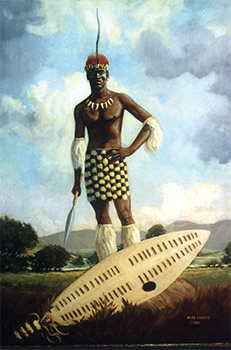 _________________________________________________________________________________________________________ Therianthrope, Mushroom Hill, Cathedral Peak, Natal Drakensberg Mountains. A shaman in trance is transforming to become a reedbuck, to harness and express its animal potency. Shaman
_________________________________________________________________________________________________________ Shaman at Battle Cave, Injasuthi 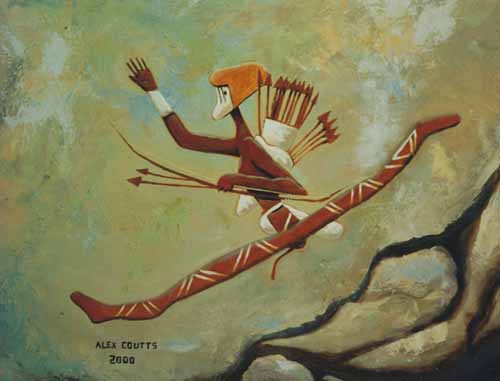
_________________________________________________________________________________________________________ Therianthrope (above), Mushroom Hill, Cathedral Peak, Natal Drakensberg. This is a further example of a shaman transforming to become a reedbuck and so absorb and express its potency. Shaman in Trance
_________________________________________________________________________________________________________ The strong contrast between the red-brown and white of the coat threw up the challenge of not ending with a sharp edged, cut-out figure if each patch was too clearly delineated. It was therefore necessary to make the edges of each little patch soft or even a bit ragged. This aided blending and helped to ensure that the powerful creature melded well enough into the cold surrounds. Speckled Red _________________________________________________________________________________________________________ The pots are household utensils I know well, and are therefore old friends. The strelitzia flowers are from the waxy strelitzia regina plants in my family’s Durban North garden. Working from life with familiar shapes and objects provides a measure of assurance and insight that aids the processes of painting. A problem arose with the flowers set against the background, because the brown pots, green stems, sharp leaves and rapier-like orange-and- blue flowers represent a quite extensive range of colours. The available spectrum implied employment of a contrasting, lighter tone and greyed colour for the background if the subject was to stand out sufficiently. A muted, nondescript warm grey seemed appropriate. Strelitzias with a Blue Pot _________________________________________________________________________________________________________ I like these pots because their simple round shapes throw up problems of tones and drawing that will reflect their solidity as the light plays on their surfaces. Tackling a range of subjects from portraits and figures to still life, wildlife, local scenes and landscapes, surrealism and abstracts has presented a range of problems, but also opportunities. Such diversity counters the humdrum sameness that can come from focus on a single genre or even one basic theme. Most of these paintings rely on freehand drawing based on an intensive study of the subject. Nevertheless, I’ll often rely on photographs as reminders, after gaining field experience of the subject. Some intricate subjects will even be projected mechanically and the outline drawn to ensure precision. But, no matter what technical devices are used for initial drawing, one still has to rely on an understanding of shapes and also one’s graphic skills to then place by freehand each of a thousand ensuing brushstrokes. Accordingly, as a younger person I spent two years of intense focus drawing white plaster objects, studying the effects of light on them, and working out the tones needed to convey a sense of solid reality. Much contemporary art shows a neglect of such discipline, in favour of unadulterated ‘creativity’. One is, of course, best served by harnessing creativity as well as technical skill. Strelitzias with Brown Pots _________________________________________________________________________________________________________ In this painting, surrealism beckons again. The work shows a visual representation of San (Bushman) mythology surrounding the killing of an eland and the supplication made during a ‘trance dance’ to the Creative Being (Cagn) who provided it. The topmost images include a shaman holding the tail of a dying eland, with the animal sweating, exuding blood through the nose, and sinking to the ground as result of the strike of a poisoned arrow. The shaman is simulating the animal’s death in empathy with the honoured creature that Cagn has so freely provided. One of the books on this website goes more deeply into San myths. It took forty years of research, followed by just two months of writing. The painting tends to be rather schematic to show the mythology, stages of the hunt, trance dance, and related cameos. The floating shapes, misty surrounds and unreal yellow sun stamp the painting as surrealist. Fairly flat shapes were created, to be in sympathy with the rock art of the San. The observer is advised to start at the lower scene, and work upwards. The Eland Dance _________________________________________________________________________________________________________ The painting is a composite, comprised of elements derived from the midlands of Natal and foothills of the Drakensberg Mountains, to create an imaginary landscape reminiscent of the area. It represents a scene from former times, when wooden carts were in operation amongst Boer (Afrikaner farmer) and British communities. One of these vehicles gave its name to the Karkloof Falls of the region (Wagon-cliff Waterfall). The old cart lay at the roadside for many years, decaying gradually in the moist climate. Traditional procedures were used, with the composition mapped out freehand before blocking in main, abstract shapes with thin turpentine paint using just ultramarine blue, burnt sienna and yellow ochre and (eventually) white. Tones were then refined as I also worked towards sharpening the colours and refining the drawing. Edges were given attention, and the process extended to correcting errors of drawing, tone, colours and edges. As many fine artists have attested through the centuries, painting is largely a matter of correcting errors. The Old Farmhouse _________________________________________________________________________________________________________ The painting was precipitated by a scene on Durban South Beach. ‘Dad’, a stranger to me, had brought in a catch of two Natal snoek (scomberomorus plurilineatus, or queen mackerel) weighing a couple of kilograms. It was a fine catch. The young son came up to see what dad had caught, and compared his catch, a small glassnose anchovy, with that of his father. His sister applauded her older brother’s efforts. The sea and sky are painted with broken colour to put some extra life into this painting, with its focus on children. One doesn’t need something drab when youngsters are around. The sea is done a bit impressionistically, since it isn’t the focus. Focal points, such as the boy’s face, are afforded a bit more precision and detail. The Optimist _________________________________________________________________________________________________________ The fence in the right-hand distance has been dislodged and the three ‘naughty boys’ have entered the farmhouse precincts, overturned a pail of milk, and drunk their fill. A farm worker stands by a bit nonplussed, knowing that he’ll have to fix the fence yet again. The background melee of tractor, water tank, sheds, machine parts, equipment and packages was painted with attention to the abstracts they presented, rather than as ‘things’. Close attention was given to negative shapes, and the process was allowed to create identifiable objects. This approach is found scattered through all of the paintings in this gallery. It is the best way to ensure that the artists is not lured into portraying ‘things’, where one can be lured into language-dominance, and where one paints e.g. a ‘tractor’, rather than an image created by the effects of light on a complex object at a certain time of day. Three Naughty Boys _________________________________________________________________________________________________________ The picture, Umhlatuzana evening, represents a gathering storm rolling across the riverine forest landscape in late afternoon with a setting sun. Soon, rain will drench the land and regenerate the tumbling waters below. The dark, threatening sky was developed in empathy with the river scene to reinforce the power and dominance of nature. I had to retain the float and fluffiness of the clouds while also portraying their mixture of threat and benevolence, deal with the contrasting orderliness and chaos of the trees, wrestle with the serried rows of reeds that could not be overly structured and needed a tinge of randomness, manage the hardness and diverse shapes of the rocks, portray the tumble of water with light reflecting from numerous angles, and paint a multitude of eddies. The process implies frequent shifts from logical thinking to systemic thinking; then in an instant to creative, lateral thinking and back again. Umhlatuzana Evening _________________________________________________________________________________________________________ This painting, Umhlatuzana rapids, is a variation on the previous work. The Umhlatuzana is a stream or small river south of Durban. It runs through coastal lowland forest in places, where one might find reed-beds (phragmites australis) in swampy areas and red beech, thorny elm, coral tree, wild plum and pigeonwood on drier ground. The rock-beds are sandstone. Vegetation is best painted with a loose wrist and mildly careless flicking action rather than with studied, precise strokes that are likely to give cardboard cut outs and a too-sharp shape against the sky. A few prominent trunks and branches, on the other hand, can be meticulously painted to stand out and define the foliage, which one then re-shapes to explain it further. Umhlatuzana Rapids _________________________________________________________________________________________________________ The painting shows a young warrior of the Zulu nation at the time of King Shaka. His loin covering is known as an ibeshu, and the weapon he carries is a iklwa! assegai devised by the remarkable warrior-king. The beehive huts in the background are typical of the times recoded in Shaka:The story of a Zulu king. Young Warrior
___________________________________________________________________________________________________________________________ |


